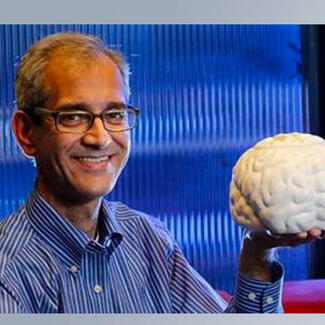
Krishna Shenoy: employing stats theory to help map neural function
Aim is to build prosthetics that will function via neural activity.
Professor Krishna Shenoy's research team has found that using statistical theory to analyze neural activity provides a faster and equally accurate process.
Krishna's team has circumvented today's painstaking process of tracking the activity of individual neurons in favor of decoding neural activity in the aggregate. Each time a neuron fires it sends an electrical signal — known as a "spike" — to the next neuron down the line. It's the sort of intercellular communication that turns a notion in the mind into muscle contraction elsewhere in the body. "Each neuron has its own electrical fingerprint and no two are identical," says Eric Trautmann, a postdoctoral researcher in Krishna's lab and first author of the paper. "We spend a lot of time isolating and studying the activity of individual neurons."
The team believes their work will ultimately lead to neural implants that use simpler electronics to track more neurons than ever before, and also do so more accurately. The key is to combine their sophisticated new sampling algorithms with small electrodes. So far, such small electrodes have only been employed to control simple devices like a computer mouse. But combining this hardware for recording brain signals with the sampling algorithms creates new possibilities. Researchers might be able to deploy a network of small electrodes through larger sections of the brain, and use the algorithms to sample a great many neurons. This could deliver enough accurate brain signal information to control a prosthetic hand capable of fast and precise motions like pitching a baseball or playing the violin.
Better yet, Trautmann said, the new electrodes, coupled with the sampling algorithms, should eventually be able to record brain activity without the many wires needed today to carry signals from the brain to whatever computer controls the prosthesis. Wireless functionality would completely untether users from bulky computers needed to decode neuronal activity today.
Krishna reports, "This study has a bit of a hopeful message in that observing activity in the brain turns out to be easier than we initially expected."
The paper, "Accurate Estimation of Neural Population Dynamics without Spike Sorting" was published in June's issue of Neuron.
Excerpted from Stanford Engineering news.